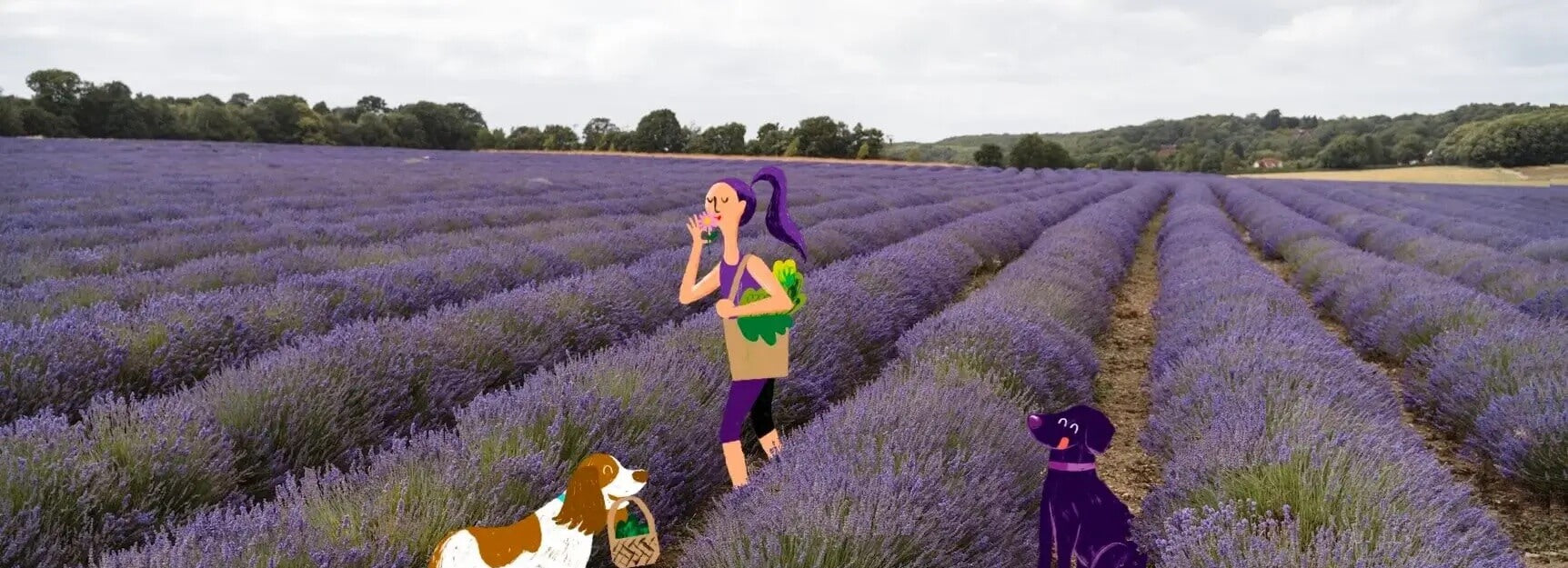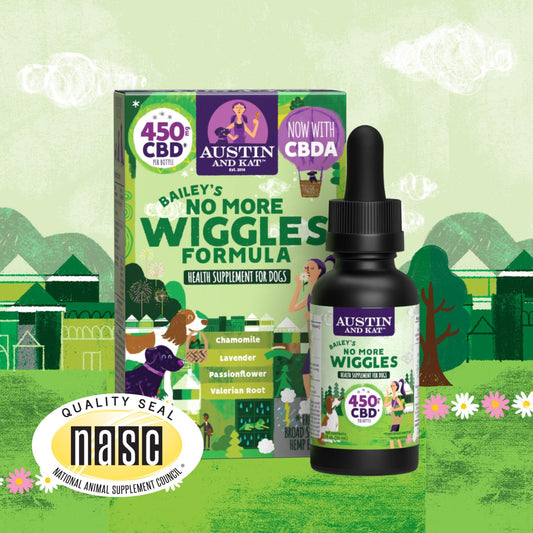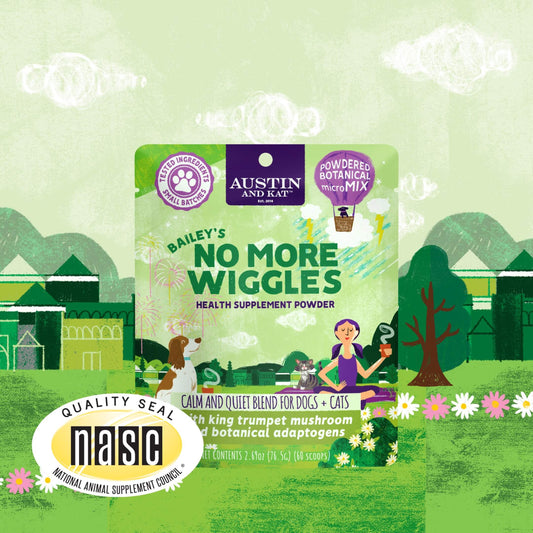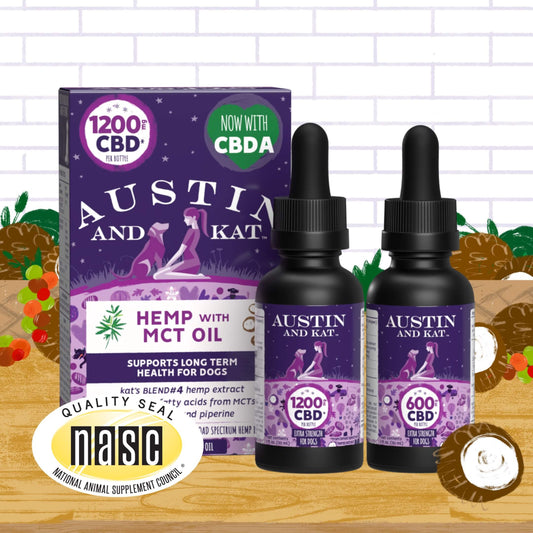
plant power
our guide to how plants have evolved to the benefit of pets (and people too)

planting the seed
Did you know that there are millions of different types of plants growing in the wild and nearly all of them are completely edible (though some are definitely lacking in the taste department!). Believe it or not, if you add up all the fruits, vegetables, herbs, and spices that people eat around the world you'll have a list of only a couple hundred. What's more surprising is that just 20 (twenty!) species of plants provide over 90% of the food that all people and pets consume on a yearly basis.
While a handful of plants have been domesticated for food, we have been using wild plants for their potent health benefits for thousands of years. In fact, over 70,000 different species of plants have been utilized in the development of drugs and medicines over time. In recent years science has begun to unlock the real potential of the plant-based world. Join us below on a journey from seed to supplement as we cover the amazing science behind Mother Nature's finest plant-based ingredients.
what on earth is an antioxidant anyway?
At Austin and Kat we're on a mission to understand which ingredients will help our four-legged friends live their best life. We get to deep-dive into which natural extracts can benefit us most, and understand the science behind their benefits.
Have you ever wondered why plants are so full of antioxidants, or what the heck an antioxidant even is? How is it that plants spend their entire lives basking in the sun's ultraviolet radiation but don't get harmed? And did you know that plants shield themselves and their DNA by creating special protections according to their environment?
We may be a little biased, but the explanation of how these compounds are so beneficial to your pet's health is worth a read so let's dig into the amazing and highly specialized skill sets of herbs, shrubs, and trees that make up the Plant Kingdom.

perfecting their craft for millions of years
Plants have been thriving on the planet for an incredibly long time, dispersing across the globe to form the base of food chains in almost every ecosystem. Fossils indicate that simple plants, rather similar to mosses of today, first evolved from freshwater algae - reaching land and finding root after the development of strong vascular tissues. Like moss and algae, plants harvest the energy of the sun through photosynthesis. They combine water, sunlight, and carbon dioxide to get the food and energy necessary to continue growing. Without proper protection, all of that work would come at a heavy cost, as the ultraviolet light from the sun is incredibly dangerous. Even worse, the reactive molecules that plants generate during photosynthesis need to be immediately contained before they cause irreparable damage to cells and tissues...who knew being a plant was so stressful?

amazing antioxidants
The answer to every plant's dilemma for a few million years has been antioxidants. We’ve all read the phrase “packed with antioxidants” or “fights free radicals” on packages before, and we’ve heard that our fruit and veg are reportedly full of them. But what are they really, and why do plants even make them in the first place (are they just being friendly)? Why are there so many different ones, and why does it sound like they all do the same thing?
In short, plants produce antioxidants to protect themselves. Particularly vulnerable parts of the plant, like fruits or flowers, get extra special attention and are prioritized for safety. Luckily for us, antioxidants play multiple roles in plants, and they often develop as dazzling pigments of color. A plant's surrounding environment and its particular niche (i.e., all the ways it interacts with other living organisms around it) plays a strong role in crafting what unique compounds are produced by each species. More importantly, individual plants develop differently according to their distinct climate, soil, and terrain. So turmeric grown on the foothills of the Himalayas will mature with a very different chemical makeup compared to turmeric grown in a laboratory (this is a proven concept that has been popularized and a little highjacked by viticulture and winemaking, known by the French term, Terroir). Below are some quick and neat examples of how and why some of our favorite ingredients that we use in our products started as powerful tools designed by plants:
Collapsible content

a blueberry is blue, right?
Did you know that the flesh of a blueberry or cranberry is actually ivory white? It’s only their skin that contains the natural dye that gives them their color. Only when the pericarp (or outer layer) of a fruit is punctured or bruised do the colorful pigments rapidly seep into the fruit below. The impressive purplish pigment that gives berries their vibrant hue is known as anthocyanin, and its color choice is rather intentional.
The colors of anthocyanins are designed to filter out yellow-green wavelengths of light from the sun. Since most plants get energy by absorbing light using a green pigment known as chlorophyll, they cannot make good use of green-colored light (if you remember from science class, something is green because it reflects that color instead of absorbing it). While the sun is required for growth, taking in too much sunlight of the wrong color is wasteful and harmful, and this is where pigments like anthocyanin come in. A host of different color varieties of anthocyanins are possible depending on factors like how acidic the fruit is or the way that the sunlight refracts through the atmosphere, yielding all the different hues of berries that we see and enjoy. It almost seems like our attraction to the color could be part of the plan, too. You’d be right to suggest that! Another important role of pigments like anthocyanins is to provide high color contrast to animal passersby, making them an attractive treat that will help the fruit disperse its seed.
So how do these pigments benefit your canine companion, especially in large amounts when in fruit-based extracts? By their nature, anthocyanins are positively charged in a unique way that allows them to absorb light. At the same time, this chemical property gives them the ability to donate their positive charge to neutralize certain free radicals if they encounter them. Because of this, taking a consistent dosage of concentrated anthocyanin can be incredibly helpful to clean up specific free radicals that are commonly making trouble in organs like the eyes and nervous system. In fact, blueberry keeps your dog healthy by protecting the brain from free radical damage and stabilizing sleep cycles, helping senior dogs maintain memory, cognitive function, and optimal health deep into their later years. Blueberries are also a very popular choice for vegan dog food options.
kids eat your broccoli...dogs too!
Cruciferous vegetables like broccoli are tough, hardy plants that take special offense to being munched by insects and herbivores. Their distinctive flavor actually comes from a protective mechanism made up of special sulfur compounds called glucosinolates. These neat molecules lie dormant in fleshy stalks and florets, waiting for the inevitable predator to come and take a bite. Following tissue damage from even a tiny nibble, a specific enzyme that is stored inside of cells comes bursting out. This enzyme meets with the glucosinolates and activates them into a completely different kind of chemical. The most important one (at least the one scientists know the most about), is a powerful compound called sulforaphane, which has been shown to greatly benefit puppies and senior dogs alike.
The idea is that insects and predators are highly likely to bring diseases to plants, much like the mosquito can bring all sorts of trouble to humans. Because of this risk, glucosinolates are produced to help the plant reduce any chance of a bite compromising their immune system. They also don’t taste that great to bugs and four-legged invaders, doubling as a deterrent to stop those predators from trying another bite. Once activated, sulforaphane and its buddies help the plant’s innate immune system neutralize and defend against any dangerous pathogens. They also send helpful messages to cells to make sure they’re ready for any trouble coming their way.
So what does sulforaphane do for your dog's diet? Sulforaphane works in very similar mechanisms in plants as it does in mammals, offering an amazing suite of benefits to create a strong immune system in the defense against pathogens and microbes (no bites required). It helps dogs with age related immunity issues and also helps the average dog's system wide immunity, just in case. Found in highest concentrations within broccoli sprouts (along with other great compounds like alpha lipoic acid), sulforaphane and broccoli sprout extracts are making their way into modern animal health regimens that are changing dog's adult years for the better.
the reliable resins of boswellia
The sweet sticky sap of the maple tree is nothing compared to the viscous resin that seeps from the knotted trunks of Boswellia! Used in Ayurvedic, Siddha, and Unani traditional medicine practices, the glue-like oils harvested from the Boswellia plant are dried into a powder by a more recognizable name, frankincense. Nowadays, frankincense is proving to be a perfect complement to traditional hip and joint ingredients for dogs as the dry resin is very effective at reducing occasional joint pain. So what is this resin, why do boswellia plants make it, and how does it help your dog’s hip and joint health?
Plants like the Boswellia tree survive in a high heat environment where there are lots of animal grazers foraging for food. In an effort to fight off the heat they produce special essential oils that are packed with volatile terpenes. Though thick and viscous inside of the plant, these terpenes evaporate at high temperatures and quickly leave, producing airflows that can cool a plant while preventing it from losing water. As the temperature rises, tiny bodies inside of plant cells present more and more terpenes to compensate for the heat.
Impressively, the same compounds have evolved to help in plant based wound healing, as the become released upon cuts and holes from predators. Due to their viscous nature, they act almost like a glue to seal and heal plant tissue. It turns out these compounds work wonders in mammals, and pet owners have found boswellia as a great complement to classical supplements like glucosamine to support bone structure and joint mobility. It's not just skeletal structure on boswellia's resume; recent medical research also shows boswellia can be great for your dog's digestion, too.
all dogs bark for this tree bark
One delicious ingredient that we love at Austin and Kat is cinnamon. Ceylon cinnamon in particular is a Sri Lankan type of cinnamon with a lot of scientific support and a milder taste that dogs absolutely love. The powerful antioxidants in cinnamon extracts can help improve joint health, support active muscles, and normalize system wide inflammation for those with health issues.
So, how and why? Cinnamon spice and the extracts that come from it actually come from the paper-thin bark of the tree of the Ceylon tree, which produces several aromatic active ingredients like cinnamaldehyde and cinnamic acid. Since the bark is thin and easy to 'invade', these oils are an adaptation by cinnamon trees to fight off infections from fungi. They contain powerful antioxidants that can neutralize dangerous compounds from pathogens, and it turns out those same antioxidants offer many benefits to dogs.
The oils in cinnamon are also a good source of vitamin E, beta carotene, and omega fatty acids, which collectively support thyroid health, brain function, the immune system, and maintaining healthy skin. There is strong evidence to suggest it helps those with heart disease by maintaining healthy blood vessels, too.
a pepper fruit family reunion
Like the taste of pepper? Mammals generally do, but insects certainly don't - that's the evolutionary purpose of the alkaloid compounds found in the fruit of black pepper plants; they'll keep your dog happy but bugs sad! Pepper plants make compounds like piperine that are very pungent and designed to invade the sensory organs of insects (they specialize in crossing cell membranes, bringing that annoying burning sensation to critters that are trying to munch them). It turns out this 'system delivery technology' backed by piperine can be used in combination with many different supplement compounds, helping them gain entry into cells and delivering more bioactive and bioavailable nutrients. This makes compounds in black pepper an incredible natural boost to your dog's defenses.
Did you know that black pepper fruit is a distant cousin to hemp and cannabis? Scientists recently discovered that black pepper fruit contains terpenes and endo-cannabinoids that are similar to CBD. Recent studies have shown black pepper activates a mammalian antioxidant with the science-heavy name of superoxide dismutase. It turns out together they can improve a dog's cardiovascular system and help support long-term health against heart disease.

clean & consistent extraction techniques
When supplement shopping for plant based dog supplements it's important to remember not all antioxidant supplements are created equally. Your furry friend deserves the best, and the best above else means a clean and standardized extraction method. Standardized extracts consistently deliver the same profile of active compounds, giving your dog the best opportunity at experiencing benefits.
Over the years, a variety of different solvents have been used in the extraction of botanicals and natural products. While each method has its benefits and drawbacks associated with purity of extraction, there are some clear winners associated with safety and risk prevention for people and pets. We recommend searching for products that are extracted in a laboratory using methods like ethanol extraction (a method that has been around for thousands of years) or Supercritical CO₂ extraction, which is a green process where carbon dioxide is used as a clean and recoverable solvent to extract compounds from plant material. These extraction processes are used to create essential oils, natural flavors, and plant based extracts. They're the gold standard of modern technical methods and they're commonly used by high-quality supplement and pharmaceutical manufacturers alike. Read more about it here!
protecting plants and building biodiversity
Thanks to factors like climate change and deforestation, experts believe that plant species are going extinct somewhere around 5,000 times faster than they would naturally.
Our partnership with the Pet Sustainability Coalition provides us an opportunity to try and make a difference! Learn more in our dedicated section on green manufacturing
we've got the plants!
Natural ingredients from plant based sources and an antioxidant rich diet can do wonders for every dog's health! All of our formulas include some of the very best plant based antioxidants for dogs, extracted from antioxidant rich foods and plants. While typical pet food will provide a diet rich in essential vitamins (e.g., vitamin C, vitamin E, B vitamins, beta carotene), it will lack the collection of natural antioxidants that can be found in balanced supplements. Your dog's food might have a few vegetables that you'll find on any grocery store shelf (like sweet potatoes, green beans, tomatoes, etc), but they'll never rival the global selection of plant-based ingredients available here.
-
No More Wiggles Chew
Regular price $49.95Regular priceUnit price / per -
No More Wiggles Oil
Regular price $64.95Regular priceUnit price / per -
No More Wiggles Powder
Regular price $29.95Regular priceUnit price / per
some vegan highlights
Looking for vegan dog food for a vegan dog? There aren't that many vegan dog food brands that offer plant based dog food, and the pet food industry as a whole has been very focused on animal products instead of plant based protein and a plant based diet. We don't currently make vegan dog food, but we do offer vegan supplement options for dogs on a vegan diet. Check out our chews below!
-
Blanca's Marine Algae Oil
Regular price $39.95Regular priceUnit price / per -
Small Batch CBD Soft Chews
Regular price From $24.95Regular priceUnit price / per -
Extra Strength CBD Oils
Regular price From $69.95Regular priceUnit price / per






